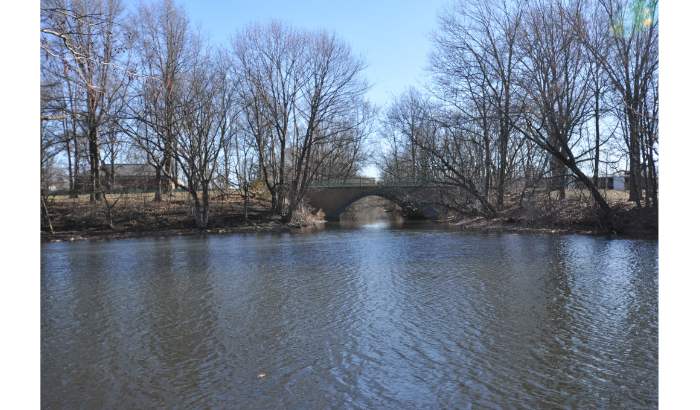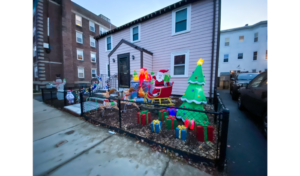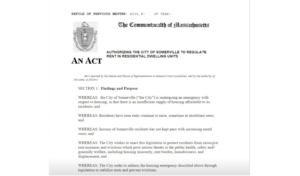Somerville, Cambridge, MWRA jointly update communities on long-term environmental planning to protect waterways from wastewater
(Somerville Wire) – Most sewer systems in the United States have two dedicated, separated networks of pipes—one for sewage and one for stormwater.
But many parts of Cambridge and Somerville have combined sewer systems, with one network of pipes for both sanitary and stormwater flow.
Only about 5-10 percent of Somerville and 60 percent of Cambridge are served by a separated sewer system, according to representatives of the cities, who discussed the problems of combined sewers at a Dec. 15 virtual meeting organized by the two city governments and the Massachusetts Water Resources Authority.
At the start of the meeting, the audience was asked to respond to a poll on where they live. Of the more than 100 people watching the video presentation live, 25% said they were from Arlington, 21% from Cambridge, 19% from Somerville, 9% from Medford, 9% from Boston, and 19% from “other.”
“I personally find it shocking how few people think about sewers,” said Rich Raiche, Somerville’s Director of Infrastructure and Asset Management, who thanked the audience for taking the time to attend.
Beginning his presentation, Raiche assured the public that “no one at Cambridge, Somerville, or the MWRA thinks that dumping raw sewage or any other form of pollution into the Alewife, Charles, or Mystic is a good thing. We are all committed to improving our systems, reducing pollution, and improving quality of life for all of our constituents and our customers.”
Raiche explained that Arlington, Medford, Watertown, and most other municipalities in the area have separated sewer systems. “Residential sewage and industrial wastewater is collected and conveyed to the MWRA Deer Island Treatment Facility, to remove solids, nutrients, organic waste, before being discharged to Boston Harbor,” he said. “Stormwater is collected in a different set of pipes and discharged to nearby surface water bodies, including the Alewife, Mystic, and Charles.”
In Cambridge and Somerville, sanitary flows and stormwater runoff all go together to Deer Island for treatment. But during very heavy rainstorms, excess flow can overwhelm the system and cause combined sewer overflows (CSOs) into the Alewife, Charles, and Mystic. The overflows contain bacteria, nutrients, and other pollutants that create debris, oil slicks, odors, and other water quality impacts in the waterways.
“Now obviously a CSO sounds bad, and clearly it is. We’re talking about getting sewage into the rivers. So that raises the question, why do we permit combined sewer overflows at all? The simple answer is that they are a necessary evil,” Raiche said.
When combined sewers become overwhelmed, wastewater can escape the system through manholes and catch basins, creating sanitary sewer overflows in residential areas. “This creates acute health risks and exacerbates flooding in those areas,” said Raiche. “Similarly, system backups can discharge directly into basements and garden-level apartments, causing property damage and very acute health risks.”
In order to prevent those negative outcomes in densely populated areas, combined sewer systems are designed with overflow structures that can divert the excess into a nearby water body. CSOs “provide controlled relief at known locations to better manage the hazards of a combined system,” Raiche said.
State and federal environmental regulatory agencies are requiring that Somerville, Cambridge, and the MWRA jointly develop a new CSO Control Plan. According to Brian Kubaska, assistant director of engineering at the MWRA, the first plan was developed in the late 1990s and addressed 86 CSOs throughout the entire Boston area. Costing over a billion dollars, “the first plan got us a long way, with annual CSO volumes reduced by 87%, or a 2.8 billion gallon per year reduction,” he said.
The Charles, Upper Mystic, and Alewife Brook had 35 CSOs in the late 1980s. “The first CSO Control Plan closed 19 of those, and made substantial reductions in the amount of overflow, about 99% for all those three water bodies,” Kubaska said.
“Although substantial CSO reductions have already been made, our work isn’t done,” he continued. “We are at the beginning stages of developing these next CSO plans and are here today to update you and get your feedback at this stage in this multi-year planning effort.”
The initial schedule was to have a draft plan by June 2023 and a final plan by December 2023. The cities and MWRA have requested an extension to this schedule. One reason, said Kubaska, was to get more public input in the planning process.
“It’s very important that we hear from you, so that the final plan reflects the public’s ideas and sentiment. To help facilitate this, we are planning to hold up to seven public meetings on major milestones—this is the second—as well as make flyers, fact sheets, and conduct stakeholder interviews. So making sure we engage with you here, and hear your thoughts, is one primary reason we requested a three-year extension.”
Another reason is to ensure that “we’ve had enough time for thorough alternative development and analysis,” he said.
As global warming brings more intense rainstorms, the threat of localized flooding and wastewater overflows increases. Both Cambridge and Somerville have been examining the potential effects of climate change and making climate resilience plans. Officials stressed the need to consider potential climate change effects as part of the CSO control plan.
Cambridge DPW Commissioner Kathy Watkins emphasized that one of their main goals is “to create a new approach to combined sewer overflow planning that we’re really excited about, to be able to really incorporate climate change in a really robust way into the planning.”
The EPA, in particular, has been “pushing us to consider climate change, and yet not really providing any guidance,” Watkins said.
“We’re not aware of any CSO plan across the country that has incorporated climate change. DEP and EPA do not have any standards … and no direction on how to incorporate climate change,” she said. “Since it’s never been done, it has been a tremendous amount of work and effort.”
To tackle these questions, the planners enlisted Dr. Indrani Ghosh, a senior climate resilience specialist at the environmental engineering firm Weston & Sampson. Ghosh has extensive experience with climate change impacts, and has led several regional and state climate resiliency projects.
Ghosh explained the concept of a Typical Year, which they will use to project future rainfall. “A Typical Year of rainfall is a full year of rain that is most representative of rainfall conditions over a selected period of time. This term is unique to the CSO control planning process, where a typical year needs to be established to assess how select alternatives for decreasing or eliminating CSOs would perform under a series of rainfall events,” she said.
The development of the typical year for the updated CSO control plan “was the first of its kind,” Ghosh said, “a data-driven process of developing a typical year that considers future rainfall projections from climate change scenarios. This was a rigorous and extensive technical analysis that was peer reviewed by leading climate experts.”
The typical year is used in two different ways, she said—during the development phase when CSO mitigation options are being considered, and during the implementation phase where mitigation options are assessed to measure their effectiveness in reducing CSOs. The data series will be run through a computer model to determine the level of CSOs to be expected over the coming years, creating a baseline to predict and analyze future conditions.
Responding to a question from the audience about the overall goals of the project, Raiche said the primary goal, “which is both regulatory and I think moral, is to reduce and eliminate, if possible, CSOs.” But Cambridge and Somerville have other responsibilities to their sewer customers as well.
“What’s bringing us to the table is the CSO issue, but we do have to look at our system improvements holistically,” Raiche said. “Cambridge has been on that path for at least two decades that I’m aware of—because I’ve been in the consulting world and have worked for Cambridge for the past two decades. Somerville has really started to focus on that within the past five, and we have done more construction in the past five years and have more plans for the next year than the previous 75 combined. So there’s a huge commitment at all levels here in Somerville to improve the system for all of those goals.”
Watkins added, “I hope people really do understand the level of effort and commitment and creativity that’s really been involved in how to effectively incorporate climate change into this process. That is a substantial commitment and really a completely new way of doing this.”
Residents of Somerville, Cambridge, and surrounding communities are invited to take a survey about the CSO issue, which is available in multiple languages. The survey will remain open until Jan. 5, 2023.
Photo credit: The mouth of Alewife Brook at the Mystic River. The bridge carries the Mystic Valley Parkway bewtween Somerville and Arlington, Massachusetts. Photo by Magicpiano. GNU Free Documentation License 2017 Magicpiano.
Linda Pinkow is a reporter for the Somerville Wire. She is also a development consultant for the Boston Institute for Nonprofit Journalism





